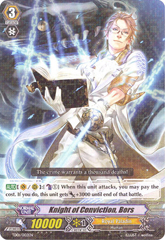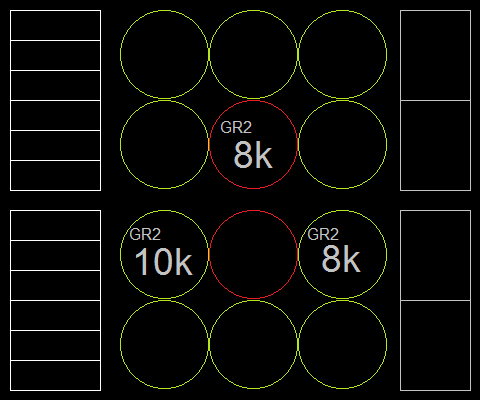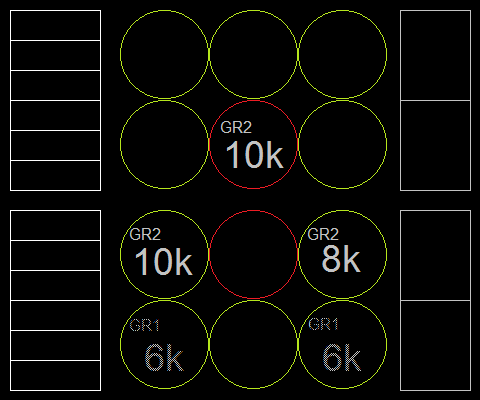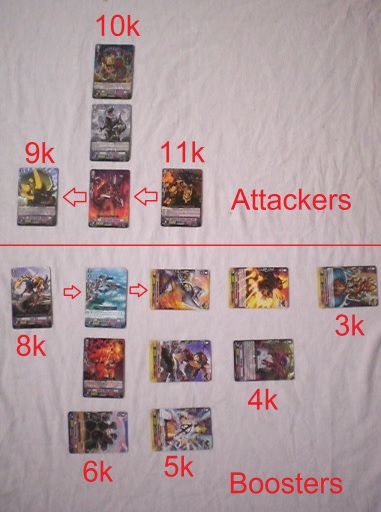Lesson 1: Magic Numbers
- Brampton Booster
- May 26, 2012
- Comment
Woah there! This is an archived article talking pre Set-5. If you want to look at more current stuff visit my main page.
If there is one thing you should know in vanguard before even looking into this blog is hitting for magic numbers. Maybe you haven’t heard of the term in this context, but you should have known what it is. So enough dodging around, what is it?
Basically, it’s when you attack a unit with a total power which is a multiple of 5000. Such as hitting a 10000 vanguard for 15000,20000,25000,etc.
Why? Well, if you look at shields for any longer then 1 minute you’ll find they come multiples of 5000There is no 6000 or 4000 Shield. Using that info, that means if you attack with the following power:
10k vs 10k : need a 5k shield
11k vs 10k : need a 5k shield
12k vs 10k : need a 5k shield
13k vs 10k : need a 5k shield
14k vs 10k : need a 5k shield
15k vs 10k : need a 10k shield or TWO 5k shields
(Note: For Shield I frequently use \S/ for less character space)
Of course, hitting for +5000 means they have to guard with 10000, not 5000. Hitting with anything from 10-14k is the same, so there is no need to add Power unless it goes into the next multiple. The following unit is found in many different clans:

Knight of Conviction, Bors
AUTO: [CB1] If this unit attacks, you may pay the cost. If you do, this unit gains POWER+3000 until the end of the turn.
If you have a unit with that unit on the field, and you attack an opponent’s 10k unit. Looking at my handy table up there you can see 10k and 13k makes NO DIFFERENCE in this situation.
People just don’t get it. Don’t power up a unit UNLESS it’s going to a different stage. Plan beforehand what you want to hit, and boost numbers accordingly. I don’t want to see Margal’s being used just to give 3k to a unit that doesn’t need it.
Now right know if your going ‘I get it!’ and are starting to rush off smacking everyone with 15k attacks (Because they have 10k VG) I say not so fast.
10k was only an example; there are units that range from 3000 all the way to 11000. You can’t just hit everything for perfect numbers, so what do you do? Let’s give a scenario:
Scenario

Your opponent has a G2 8k VG and you have a GR2 10k and GR2 8k RG.
You have a 6k booster in your hand. Let’s add what happens if you give the 6k to the two units. On the right a 10k and a 8k still requires 5000 worth of shield, same if you are attacking with a boost of 6000.
10k vs 8k : need a 5k shield »> 16k vs 8k - need a 10k shield
8k vs 8k : need a 5k shield »> 14k vs 8k - need a 10k shield
Hey! They are the same! That means it doesn’t matter which unit you give it to! right?
WRONG
While it may SEEM the same now, but look at what happens next turn when the vanguard becomes a GR3.

Now if you gave it to your 8k, it would be hitting for 14000: 1k shy of needing another 5000 \S/. And don’t think for a second the opponent has to guard with the same number for both attacks altogether. Your 8k can intercept! Get rid of it if you have another unit you want to call out (like those plentiful 10k). Or if it can’t intercept, call a stronger booster(like those 8000 Powered Grade 1’s). By the third turn you should already have acquired stronger boosters and/or attackers. Don’t settle for less and make it hit for a clumsy 14k every turn. Remove it and hit for higher numbers. Same goes for bringing two grade 0/1’s on the same row. It’s messy because it doesn’t hit high, it locks your field it lets on hit effects to activate and if you replace it you lose a card. Don’t rush by calling a bunch of units out. GR1’s in the front row should not have a booster behind it.
As for what to hit, there are 2 main numbers to hit; 10k and 11k.
Hitting 10000
10k units are plentiful. Most GR3’s have 10000 power, and a bunch of GR2’s have it as well. The average deck will have around 30-45% of their attackers starting with 10k.
10k vs 15k : This is a great number to hit, causing the opponent to guard with 10000. But it is really an awkward number to hit. You either need a 5k>10k, a 6k>9k or 7k>8k. The thing is 5, 7 and 9 are not popular numbers (6,8, and 10 are more common for base power). In most cases, you will get a 15k attack by checking a trigger
10k vs 20k : Any number that is equal or over 20000 is scary. That Bors behind a 7k or 8k booster will do wonders. A 12k attacker and an 8k booster also hits 20k. 14 and 6, 13 and 7, 11 and 9, there are many ways to create a 20000 atack coloumn. Your vanguard will usually bypass this limit as well with its trigger checks.
Hitting 11000
11k is a troll if you don’t know how to hit it. Stop and think for a moment about the numbers your hitting for 10k. Hitting 15k requires 10000\S/ against 10k, but only 5000 for 11k. Same downgrade goes with 20k. And since there are quite a few clans with 11k VG, it’s going to hurt you if you have pairs of units which hits for 15k and 20k. Even if the clan has one 11k unit, caution should be used. It is safer to assume they will have an 11k vanguard. If they don’t that is fine, hitting for 1000 more then you need to isn’t as bad as the opponent using 5000 less shield to stop you.
8k GR2 sometimes have effects that boosts there attack by 3k based on certain conditions. What does this mean? It means they are now hitting for 11k! Most clans have at least one GR2 that can reach into the 11k zone. Right here I have a list for GR2’s that go to 11k(For the current English Format):
RP - Covenant Knight Randolf, Eagle Knight of the Skies, Gigantech Dozer, Swordsman of the Blaze Palamedes
OTT - Battle Sister Mocha, Onmyoji of the Moonlit Night, Battle Sister, Glace
GB - Ruin Shade, Undead Pirate of the Frigid Night, Greed Shade
GP - Charging Chariot Knight, Gigatech Commander
NK - Hex Gun Wyvern, Brightjet Dragon
DI - Demon of Aspiration Amon
NB - Stealth beast Chigasumi
PM - Crimson Beast Tamer
GN - Multimeter Giraffe
AF - Ironheart Mastema
NG - Kungfu Kid Bolta
etc.
Depending on the ability to gain power, they can be treated like 11k or 8k units. A unit like Mocha, which gains power if you have 4 or more cards in your hand, should be considered an 11k unit. Something like Chigasumi or Greed shade however is slightly inconsistent. For these units, either place them alone, or have a 7k/8k unit behind them. Do not put 6000 behind it because it you do and you don’t get the power boost, you’ll get a lame 14000 attack that won’t help you at all.
16k is the best minimum number to hit in Vanguard. The entire game almost revolves around this as well. This number requires a 10k shield for next to everything. And there are so many different ways to hit this number I’m not going to even try to list them all. However, a couple of key combinations is a 10k in front of a 6k, and two 8k units.
Now, let me turn this around and show you what it’s like to be an 11k Vanguard. It’s a nice number defensively because it throws off the easier 15k and 20k combinations. Offensively on the other hand, it’s quite poor because it doesn’t hit for magic numbers: Even an 8k booster brings it up to 19000, just under the magic number. 11k units fair pretty well by themselves, but if you decide to boost don’t consider too much on hitting for magic numbers. Instead think about the power of the unit you will replace it with when the time comes.
Early Game - Hitting 8000
8k attackers are found in two main types: a GR1 vanilla and a GR2 unit with an ability. Just remember, after the early game is finished (or more specifically, once your opponent rides a unit with 10000 or more power), NEVER put that 6k behind that 8k. If you’re certain that you can get rid of either the booster or attacker BEFORE the start of that Grade 3 ride, you can have a 6k and 8k. However, if it isn’t certain, don’t take the risk. Ever.
For each case that you would actually pair up to hit 14k:
- The booster is a returning trigger. These are units that return to the deck at the end of the turn, NOT when the attack hits. Examples are Lozenge magus, Battleraizer and Turboraizer. Rainbow Magician and Black Cannon Tiger are NOT examples of this.
- The attacker is an S-intercept unit. These are units that gain shield when they intercept. Examples are Security Guardian, Knight of Truth Gordon and Nemean Lion.
8k vs 13k : 13k is becoming more and more manageable to achieve. Remember Bors? That unit is particularly useful for hitting any troublesome 8k units alone. Also, a Trigger will automatically boost an 8k into 13k.
8k vs 18k : Not really necessary, and at this point I doubt anybody will want to guard that attack. But you will probably experience this frequently by putting a grade 3 and a 8k booster together. However, it is better to have a grade 2 8k instead, because those boosters are precious. Bring the grade 3 in front when you need an attack but lack a viable option(GR2). The situation you will go 18k is if you desperately need an on hit effect to work or remove a silly Silent Tom.
6000 vs 7000
1k changes games.
Let’s say I have the very frequent 8k Rearguard. As I’ve stressed and stressed before, I forbid you to boost a 6k with 8k. 14k is going to do jack squat against any reasonable player. However, 7k allows for the ever frequent 8k pop into the realm of 15000! That allows you to hit 10k Vanguards and Rearguards with ease. Boosting 9k and now it goes for that oh so beautiful 16k. Bors-clones will be able to go to 20k instead of 19k, and +3 and +4 vanguards no longer need an 8k behind it and so it can help other units. All that makes 7k a very good number. As for the skill, yes it is worse but the number is very helpful for the big and easy numbers: 8,9,13&14. 6000, it only helps 10k, with little nudge of 9k/14k. There are also a few 7k Grade 2’s; they are bad because they fall just as easily as an 8k unit. As for an attacker, they need a huge reliance on vanilla boosters to be even remotely useful (and almost obsolete against 11k vanguards) so if you do put one down, intercept with these units ASAP.
Making sense
Okay now, this is what I want you to do. Sort out your deck and arrange all the boosters from highest to lowest power in a row, same power units should ascend down. Put all the attacking units, Grade 2’s and 3’s above and arrange it so you get 16k. Below is a (slightly blurry) image of my Pre-Jurrasic Tachikaze deck sprawled in the way I described, piled in 4’s:
Okay, as you can see I have 4 Sonic Noahs(8k) to boost Blightops(9k). If I put a 6k, then Blightops only goes to 15000, not bad, but not what I’m putting up with in today’s 11k vanguards. That means Sonic Noah isn’t dependent on Blightops, but Blightops is very dependent on Sonic Noah.
Twelve 10k attackers are joined by only 11 boosters. But you see that arrow to the right? That means Sonic Noah doubles back and brings that total up to 15. And so on. On the top half, arrows represent what else they can be boosted by. Obviously we see that Sonic Noah helps everyone, but the poor Crit can’t even help my 11k. If a particular number is overloaded, you might consider switching some of the units. Although quite obvious, the more powerful units have more possibilities to hit magic numbers, but the weaker ones must be held in hand until its pair shows up. The rested units shows units that I won’t place onto the field, and usually they are triggers.
If you look at the curve on each side, it is generally balanced. The ideal field in a pure numerical sense would be to have all the boosters on the Noah side, with all the attackers on the 11k side. In building your deck however, you also need to consider the effects of those units. But this is one of the ways to represent your deck, to show the dependence of each card numerically. In the early stage, this is a great way to see how often you will be hitting for magic numbers. Building on Magic numbers is the microstage of the winning image and field formation, so if you can consistently go for these numbers you’re well on your way to beating your opponent.
Theory into Practice
If you have a 10k attack, and your opponent is at 11k, and you have a a 5k booster in your hand, what do you do? Really, it’s much better to keep that booster in your hand. There is a much better chance of getting a trigger, getting a higher powered boosting unit and/or obtain another attacker then you might think. Wait a turn and play it out. Vanguard is not such a blitzkrieg as you might believe.
If they have a 10 vanguard for the above scenario, it is truly how it plays down. Consider if they have an 11k at all if you decide to play it. Other wise, you’ll need to replace the booster to do some damage. Note the difference in power when your hitting the two stages, and if your not sure about what your opponent’s final vanguard will be, treat it as an 11k.
Create meaningful columns. If you need to wait a couple turns to do so, then wait. Plan to set either a 15k or 20k column at each end if your facing a 10k Grade 3, and 16k/21k if you know they have an 11k vanguard. Being sloppy with 14k columns is going to cost you.
And Finally
Unboosted Rearguard atack: Get the opponent to guard with at least 5000
Boosted Rearguard atack: Get the opponent to guard with at least 10000, by creating a column of 16k minumum
I know it was a long article, but it is the most important one. Don’t get so overworked about it. As you play you’ll naturally learn how and when to hit magic numbers.
« Lesson 0: Understand Cardfight!! Vanguard’s Meta » « Lesson 2: Deck Staples »

